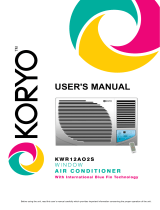
2
WARNING
Plug in power plug properly. Otherwise, it may cause electric shock or fire due to excess heat
generation.
Do not operate or stop the unit by inserting or pulling out the power plug. It may cause electric
shock or fire due to heat generation.
Do not damage or use an unspecified power cord. It may cause electric shock or fire. If the
power cord is damaged, it must be replaced by the manufacturer or an authorized service
centre or a similarly qualified person in order to avoid a hazard.
Do not modify power cord length or share the outlet with other appliances. It may cause
electric shock or fire due to heat generation.
Do not operate with wet hands or in damp environment. It may cause electric shock.
Unplug the unit or disconnect the power supply to the unit, if strange sounds, smell, or smoke
comes from it. It may cause fire and electric shock.
Do not use the socket if it is loose or damaged. It may cause fire and electric shock.
Leave the door closed while the air conditioner is running. It is not designed to cool the entire
house.
Do not use the power cord close to heating appliances. It may cause fire and electric shock.
Do not use the power cord near flammable gas or combustibles, such as gasoline, benzene,
thinner, etc. It may cause an explosion or fire.
Ventilate room before operating air conditioner if there is a gas leakage from another
appliance. It may cause explosion, fire and burns.
Do not disassemble or modify unit. It may cause failure and electric shock.
The appliance shall be installed in accordance with national wiring regulations.
If connecting power to fixed wiring, an all-pole disconnection device which has at least 3mm
clearances in all poles, and have a leakage current that may exceed 10mA, the residual
current device(RCD) having a rated residual operating current not exceeding 30mA, and
disconnection must be incorporated in the fixed wiring in accordance with the wiring rules.
The unit s circuit board (PCB) is designed with a fuse to provide overcurrent protection. The
specifications of the fuse are printed on the circuit board, such as: T 3.15A/250V, etc.
This appliance can be used by children aged from 8 years and above and persons with
reduced physical, sensory or mental capabilities or lack of experience and knowledge if they
have been given supervision or instruction concerning use of the appliance in a safe way and
understand the hazards involved. Children shall not play the appliance. Cleaning and user
maintenance shall not be made by children without supervision. (EN Standard requirements)
This appliance is not intended for use by persons (including children) with reduced physical,
sensory or mental capabilities or lack of experience and knowledge, unless they have been
given supervision or instruction concerning use of the appliance by a person responsible for
their safety. (IEC Standard requirements)
Children should be supervised to ensure that they do not play with the appliance.
If the supply cord is damaged, it must be replaced by the manufacturer, its service agent or
similarly qualified persons in order to avoid a hazard.
The appliance shall be installed in accordance with national wiring regulations.
Do not operate this appliance in a wet room such as a bathroom or laundry room.
The appliance with electric heater shall have at least 1-meter space to the combustible
materials.
Contact the authorized service technician for repair or maintenance of this unit.




















